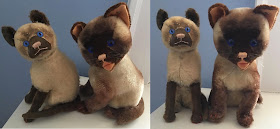What would you like to find in your Easter basket? A chocolate bunny, some neon-colored marshmallow Peeps, and jelly beans would be a good start for sure. But how about a Steiff rabbit surprise as well? No Steiff collector would say no to that! Steiffgal recently welcomed two Steiff rabbit rarities into her hug. Given the Easter rabbit is about to make his grand annual appearance, she though it would be a perfect time to share these honey-bunnies with the Steiff loving community.
It's a clothes call with this first cheerful-earful. Here we have Steiff's "Zappy" rabbit. He is 25 cm, head jointed, and made mostly from
tan and white dralon. His footpads and the lining of his ears are the same dralon color - a very light peach. He is wearing green felt shorts and rust-brown felt
suspenders. Little silver buttons join the suspenders to the shorts. His face
is detailed with large brown and black pupil eyes, a pink hand embroidered nose
and mouth, pink airbrushing, and lots of clear monofilament whiskers. His IDs include a raised script button, a fully legible yellow ear tag which is numbered 8625,00, and a colorful, named, bear faced chest tag. His article number corresponds to 8=dolls and figures, 6=dralon plush, 25=25 cm, 00=without wheels and "normal color." Zappy was produced in this size only from 1966 through 1974.
So what secrets does Zappy hide deep within his rabbit den? It is interesting that at least from his numbering, we can tell that Steiff categorized this design more of a doll than a rabbit. And, a close look through the Sortiment reveals that he does indeed "live" in the dolls and figures chapter, not in the rabbits chapter. Awhile back, Steiffgal handled another example but that Zappy had lentil style Steiff buttons on his shorts, not plain ones like the example under discussion today. Zappy is one of the very last dressed animal dolls Steiff produced as part of its standard line. Steiff's animal dolls debuted in the late 1920's and were noted for their hybrid animal/human proportions and great outfits. Over time, their designs and clothing were simplified; the debut animals were made of mohair, fully jointed, and dressed to the nines. This dralon version with basic felt shorts truly represents the end of the line for Steiff's legacy animal doll production.
It's easy to warm up to this second Steiff rabbit rarity. This bunny is begging, unjointed, and measures 22 cm without ears and 28 cm with them. Her face, arms, legs, and ears are made from long tan dralon. The lining of her ears is made from apricot colored dralon. Her muzzle area is made from velour-like material. Her face comes to life with oversized black and brown pupil eyes, a brown hand embroidered nose and mouth augmented with brown paint, and clear monofilament whiskers. Bunny's body, which is shaped like an egg, is hollow and made from short green dralon. It is decorated with a red and yellow felt flower on a green felt stem. Her Steiff IDs include a lentil style button, a fully legible yellow ear tag, and a red and yellow split style generic chest tag. Steiffgal cannot find any mention of this item in any of the standard Steiff reference books. Given her arrangement of IDs, it is her best guess that this mystery rabbit was made in the c. 1972-1977 time frame.
So just why is this rabbit hot stuff? It is Steiffgal's best guess that she was originally designed as a hot water bottle animal for a small child, given her size, appearance, and form. Her belly is hollow, and you can open and close it up on the back via strips of velcro. Her belly is also lined in an unusual, rigid material that probably has some heat-regulating properties to it. This fabric was probably put inside the rabbit to insulate it, as well as protect a child from getting scalded if the hot water bottle inside the rabbit's belly was extremely hot. However, this example did not come with the interior bottle, so it is impossible to guess what it looked liked or how it actually navigated within the the body cavity.
Steiff has a long history of creating fun and functional items, including purses, pajama bags, egg cozies, and other rarities - including hot water bottle animals. Most collectors are familiar with the company's adorable and fabulous hot water bottle bears, which were originally produced at the turn of last century in response to record cold winters in Berlin. Only a handful of these lace-up, mohair cubs were manufactured, and they always garner enormous collector's interest when they appear at auction. As far as Steiffgal is aware, this relatively modern hot water bottle rabbit is one of the few (if not the only) postwar hot water bottle animals made by Steiff.
Steiffgal hopes that this discussion on these two rare Easter bunnies has satisfied your rabbit-habit!
Have a question about one of your Steiff treasures? Let's talk! Click here to learn more.





















